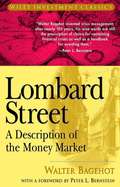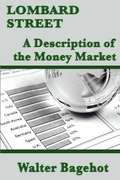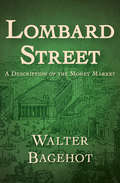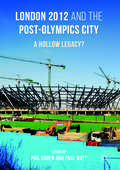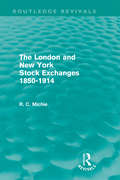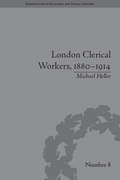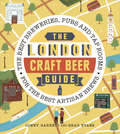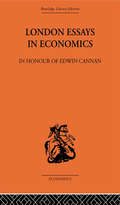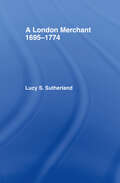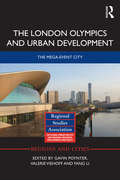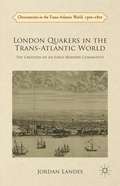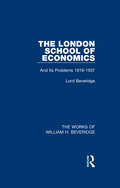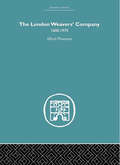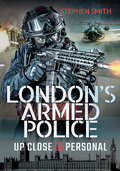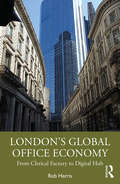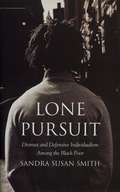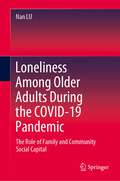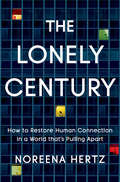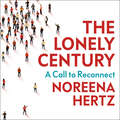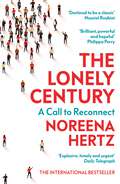- Table View
- List View
Lombard Street: A Description of the Money Market
by Walter BagehotLombard Street began as a series of articles the esteemed essayist and financial advisor, Walter Bagehot had written for The Economist during the 1850s. First published in book form in 1873, it is a vivid description of the money market that seamlessly brings together theoretical analyses, historical anecdotes, and incisive commentary on sociology, politics, and the Street's various personalities. Sharing his invaluable insights and unique observations, Bagehot touches on everything from the mechanics of deposit banking within a fractional reserve system to the nature of foreign deposits in Britain. Along with a clear explanation of why economic growth and rising living standards are dependent upon a well-managed financial system, he offers straightforward guidelines for the function of lender-of-last resort; a penetrating look at the consequences of uncontrolled credit and speculation; and an in-depth examination of the exchequer in the money market that includes a stimulating analysis of the interaction between the government's fiscal operations and the functioning of the Bank of England, the commercial banks, and the money market. Perhaps most importantly, Lombard Street features Bagehot's prescription for crisis management, which after nearly 150 years, remains the formula of choice for containing-and curtailing-financial crises. Filled with descriptions of Lombard Street that still ring true today, this jewel of a book has withstood the test of time to become a true investment classic-one that will appeal as much to the readers of today as it did to those of years ago.
Lombard Street
by Walter BagehotLombard Street: A Description of the Money Market is a famous book by Walter Bagehot, published in 1873. Bagehot was one of the first writers to describe and explain the world of international and corporate finance, banking, and money in understandable language.
Lombard Street: A Description of the Money Market (Cambridge Library Collection - British And Irish History, 19th Century Ser.)
by Walter BagehotFinancial observer and journalist Walter Bagehot sheds light on the world of banking in his influential tract Written in response to a nineteenth-century banking crisis in England, Walter Bagehot's influential treatise was one of the first to clearly explain complex financial systems like international banking, currency, and corporate finance in clear and easy-to-understand language. Credit, Bagehot suggests, is based primarily on trust. When the banks lose the public's trust, the entire system can collapse. In Lombard Street, Bagehot--who was the editor in chief of the Economist--sets forth a series of proposals for the strengthening and survival of struggling financial institutions, such as allowing irresponsible banks to collapse and creating strong central banks to combat inflation. His insights are as relevant in today's economic climate as they were when the book was first published in 1873. This ebook has been professionally proofread to ensure accuracy and readability on all devices.
Lomography: Analog in a Digital World
by Karol Misztal John T. Gourville Emer MoloneyIn spite of the world's move to digital photography, in 2013 Lomography continues to design and offer analog (film) cameras to a loyal following of artistic photographers. Now it must decide whether to stick to its traditional offerings, expand into artistic lenses for both digital and analog cameras, and/or to expand into film and film developing. In the process, it has to decide what kind of company it wants to be.
London
by Robert O. Bucholz Joseph P. WardBetween 1550 and 1750 London became the greatest city in Europe and one of the most vibrant economic and cultural centres in the world. This book is a history of London during this crucial period of its rise to world-wide prominence, during which it dominated the economic, political, social and cultural life of the British Isles, as never before nor since. London incorporates the best recent work in urban history, contemporary accounts from Londoners and tourists, and fictional works featuring the city in order to trace London's rise and explore its role as a harbinger of modernity, while examining how its citizens coped with those achievements. London covers the full range of life in London, from the splendid galleries of Whitehall to the damp and sooty alleyways of the East End. Readers will brave the dangers of plague and fire, witness the spectacles of the Lord Mayor's Pageant and the hangings at Tyburn, and take refreshment in the city's pleasure-gardens, coffee-houses and taverns.
London 2012 and the Post-Olympics City
by Phil Cohen Paul WattThis book brings together a body of new research which looks both backwards and forwards to consider how far the London 2012 Olympic legacy has been delivered and how far it has been a hollow promise. Cohen and Watt consider the lessons that can be learnt from the London experience and aptly apply them other host cities, specifically Rio 2016 and Tokyo 2020. The Olympics are often described as a 'mega-event' in a way that assumes the host cities have no other existence outside, before or beyond the contexts imposed by the Games themselves. In terms of regeneration, the London 2012 Olympics promised to trigger a mega-regeneration project that was different to what had come before. This time the mistakes of other large-scale projects like London Docklands and Canary Wharf would be put right: top-down planning would be replaced by civic participation, communication and 'the local'. This edited collection questions how far the 2012 London legacy really is different. In so doing, it brings fresh evidence, original insights and new perspectives to bear on the post-Olympics debate. A detailed and well-researched study, this book will be of great interest to scholars of urban geography, sociology, urban planning, and sports studies.
The London 2012 Olympic Games
by Marco Bertini John T. GourvilleIt's 2009 and Paul Williamson, Head of Ticketing, must finalize ticket prices for the 2012 London Olympic Games. Yet, there are many criteria to consider. First, given the importance of ticketing to the Games' bottom line, he has a strong incentive to maximize revenues. Second, because the entire world will be watching, he wants to maximize attendance - not just at the Opening Ceremony and swimming finals, which are easy sells, but also at events such as handball and table tennis, which are not. Third, he wants to fill seats with the right people - knowledgeable fans who add to the energy and atmosphere of the event. Finally, tickets had to be accessible not only to the world's elite but also to average Londoners, many of whom lived around the corner from the Olympic Park.
The London and New York Stock Exchanges 1850-1914 (Routledge Revivals)
by Ranald MichieFirst published in 1987, this is a reissue of the first book to offer a detailed comparison of two of the foremost stock exchanges in world before 1914. It is not only an exercise in comparative economic history but it also relates these institutions to wider world markets, thereby clarifying their functions and how they related to the general financial and economic framework. Students and researchers in economic and social history will welcome the reissue of this groundbreaking account of two historically important institutions in a crucial period of their development. Financial practitioners and others will also find much of interest here, in terms of both fascinating history and of insights into an era when a global market was rapidly evolving largely free of the twentieth-century distortions and hindrances introduced by wars, interventionist governments and exchange controls.
London Clerical Workers, 1880–1914: Development of the Labour Market (Perspectives in Economic and Social History #8)
by Michael HellerThis study is based on a wide range of business sources as well as newspapers, journals, novels and oral history, allowing Heller to put forward a new interpretation of working conditions for London clerks, highlighting the ways in which clerical work changed and modernized over this period.
The London Craft Beer Guide: The Best Breweries, Pubs And Tap Rooms For The Best Artisan Brews
by Jonny Garrett and Brad EvansLondon Essays in Economics: In Honour of Edwin Cannan (Essay Index Reprint Ser.)
by T. E. Gregory Hugh DaltonIn paying tribute to one of the twentieth century's most eminent economists, the essays in this volume also cover major areas of economic importance such as: Theories of population; relations between banking and the State; productivity and the theory of wages; capital and income; the development of money. Contributors to the volume include: W. Beveridge, H. Dalton, T. E. Gregory, L. Robbins, M. C. Buer, E. L. Hargreaves, E. M. Burns, F. C. Benham, W. A. Robson and D. Mitrany.
London Merchant 1695-1774: A London Merchant
by Lucy Stuart SutherlandFirst published in 1962. Routledge is an imprint of Taylor & Francis, an informa company.
The London Olympics and Urban Development: The Mega-Event City (Regions and Cities)
by Gavin Poynter Valerie Viehoff Yang LiAs London sought to use the Olympics to achieve an ambitious programme of urban renewal in the relatively socially deprived East London it attracted global attention and sparked debate. This book provides an in-depth study of the transformation of East London as a result of the 2012 Summer Olympic and Paralympic Games. Government and event organisers use legacies of urban renewal to justify hosting the world’s leading sports mega-event, this book examines and evaluates those legacies. The London Olympics and Urban Development: the mega-event city is composed of new research, conducted by academics and policy makers. It combines case study analysis with conceptual insight into the role of a sports mega-events in transforming the city. It critically assesses the narrative of legacy as a framework for legitimizing urban changes and examines the use of this framework as a means of evaluating the outcomes achieved. This book is about that process of renewal, with a focus on the period following the 2012 Games and the diverse social, political and cultural implications of London’s use of the narrative of legacy.
London Quakers in the Trans-Atlantic World
by Jordan LandesThis book explores the Society of Friend's Atlantic presence through its creation and use of networks, including intellectual and theological exchange, and through the movement of people. It focuses on the establishment of trans-Atlantic Quaker networks and the crucial role London played in the creation of a Quaker community in the North Atlantic.
The London School of Economics: And Its Problems 1919-1937 (The Works of William H. Beveridge)
by William H. BeveridgeThe eighteen years when William Beveridge was Director of the LSE, saw some of the School’s greatest expansion. The years between the wars presented a number of problems discussed in this book, such as those of finding space in the heart of London, of the proper scope and method of economics, of academic self-government and of political activity by university readers of social sciences. The last chapter tells of the author’s forty years of friendship with Sidney and Beatrice Webb, using letters between him and them that had not been published before publication of this book in 1960.
The London Weaver's Company 1600 - 1970
by Alfred PlummerThe Worshipful Company of Weavers, the oldest of all the London Livery Companies, can trace its origins to a twelfth-century craft guild. Largely based upon original records never before studied in depth, this authorized history of the company covers the period from the end of the reign of Elizabeth I to modern times. Alfred Plummer presents a portrait of the London Hand-loom weavers in their historical setting, living strenuous lives in an industry which was once essential but has now disappeared. He describes many fascinating aspects of the Company's 'eventful history', from the numbers of apprentices, to their parents and places of origin, the attitude towards the admission of women and the enlistment by the Weaver's Company of the powerful pen of Daniel Defoe. In addition, the work examines the impact of such catastrophes as the Great Plague and the Fire of London. The author deals with the dogged struggle for survival of the famous Spitalfields silk weavers, and explores the part played by the Weavers and their associated London Livery companies in the 'plantation of Ulster' under James I nearly four centuries ago. This book was first published in 1972.
London's Armed Police: Up Close and Personal
by Stephen SmithAn insider&’s account of an elite unit fighting crime and terror on the streets of London—includes hundreds of photos. In this book, veteran firearms officer Stephen Smith goes behind the scenes of the Metropolitan Police&’s Specialist Firearms Unit, CO19—covering a wide range of events in recent history, from the controversial shootings of Azelle Rodney in 2005 and Mark Duggan in 2011 to the terrorist attacks on Westminster, London Bridge and Borough Market, as well as stories from decades past. Through his unique access to CO19, Smith has managed to put together hundreds of detailed photographs, both historical and contemporary, along with text that goes a long way to explain why it is necessary to have such an elite firearms unit on standby 24/7 in London. This comprehensive volume will bring you up-to date with the training, operations, equipment, and mindset of these courageous individuals who put their lives on the line on a daily basis to keep London safe.
London’s Global Office Economy: From Clerical Factory to Digital Hub
by Rob HarrisLondon’s Global Office Economy: From Clerical Factory to Digital Hub is a timely and comprehensive study of the office from the very beginnings of the workplace to its post-pandemic future. The book takes the reader on a journey through five ages of the office, encompassing sixteenth-century coffee houses and markets, eighteenth-century clerical factories, the corporate offices emerging in the nineteenth, to the digital and network offices of the twentieth and twenty-first centuries. While offices might appear ubiquitous, their evolution and role in the modern economy are among the least explained aspects of city development. One-third of the workforce uses an office; and yet the buildings themselves – their history, design, construction, management and occupation – have received only piecemeal explanation, mainly in specialist texts. This book examines everything from paper clips and typewriters, to design and construction, to workstyles and urban planning to explain the evolution of the ‘office economy’. Using London as a backdrop, Rob Harris provides built environment practitioners, academics, students and the general reader with a fascinating, illuminating and comprehensive perspective on the office. Readers will find rich material linking fields that are normally treated in isolation, in a story that weaves together the pressures exerting change on the businesses that occupy office space with the motives and activities of those who plan, supply and manage it. Our unfolding understanding of offices, the changes through which they have passed, the nature of office work itself and its continuing evolution is a fascinating story and should appeal to anyone with an interest in contemporary society and its relationship with work.
Lone Pursuit: Distrust and Defensive Individualism Among the Black Poor
by Sandra Susan SmithUnemployment among black Americans is twice that of whites. Myriad theories have been put forward to explain the persistent employment gap between blacks and whites in the U.S. Structural theorists point to factors such as employer discrimination and the decline of urban manufacturing. Other researchers argue that African-American residents living in urban neighborhoods of concentrated poverty lack social networks that can connect them to employers. Still others believe that African-American culture fosters attitudes of defeatism and resistance to work. In Lone Pursuit, sociologist Sandra Susan Smith cuts through this thicket of competing explanations to examine the actual process of job searching in depth. Lone Pursuit reveals that unemployed African Americans living in the inner city are being let down by jobholding peers and government agencies who could help them find work, but choose not to. Lone Pursuit is a pioneering ethnographic study of the experiences of low-skilled, black urban residents in Michigan as both jobseekers and jobholders. Smith surveyed 105 African-American men and women between the ages of 20 and 40, each of whom had no more than a high school diploma. She finds that mutual distrust thwarts cooperation between jobseekers and jobholders. Jobseekers do not lack social capital per se, but are often unable to make use of the network ties they have. Most jobholders express reluctance about referring their friends and relatives for jobs, fearful of jeopardizing their own reputations with employers. Rather than finding a culture of dependency, Smith discovered that her underprivileged subjects engage in a discourse of individualism. To justify denying assistance to their friends and relatives, jobholders characterize their unemployed peers as lacking in motivation and stress the importance of individual responsibility. As a result, many jobseekers, wary of being demeaned for their needy condition, hesitate to seek referrals from their peers. In a low-skill labor market where employers rely heavily on personal referrals, this go-it-alone approach is profoundly self-defeating. In her observations of a state job center, Smith finds similar distrust and non-cooperation between jobseekers and center staff members, who assume that young black men are unwilling to make an effort to find work. As private contractors hired by the state, the job center also seeks to meet performance quotas by screening out the riskiest prospects—black male and female jobseekers who face the biggest obstacles to employment and thus need the most help. The problem of chronic black joblessness has resisted both the concerted efforts of policymakers and the proliferation of theories offered by researchers. By examining the roots of the African-American unemployment crisis from the vantage point of the everyday job-searching experiences of the urban poor, Lone Pursuit provides a novel answer to this decades-old puzzle.
A Lone Ranger: Real World Strategies for Applying Growth Opportunity Scans, Assessing Product Extensions, and Realizing the Potential of Radical Innovations
by Patricia Gorman Clifford Jay Barney"What I Didn't Learn in Business School" is a fictional account that follows new consultant Justin Campbell as he joins an elite team hired by a chemical firm to assess the potential of a newly developed technology. This chapter finds Justin struggling to get a handle on several different applications for this technology in order to determine the growth opportunity and lay the groundwork for choosing the highest-potential innovations. Learn from his mistakes as he looks for ways to organize information effectively and evaluates strategic opportunities. This chapter was originally published as Chapter 8 of "What I Didn't Learn in Business School: How Strategy Works in the Real World."
Loneliness Among Older Adults During the COVID-19 Pandemic: The Role of Family and Community Social Capital
by Nan LUThis book investigates the relationship between social capital and loneliness of older adults living in urban China during the COVID-19 outbreak period. It also tested the mediation role of community-based cognitive social capital on the relationship between community-based structural social capital and loneliness of older urban Chinese adults.This book targets at a broad audience with knowledge in social gerontology and social work with older adults. It will appeal to academic researchers, undergraduate and graduate students, policymakers, and social workers who have interests in social capital and mental well-being in later life, and the impacts of COVID-19 on the well-being of older adults.
The Lonely Century: How to Restore Human Connection in a World That's Pulling Apart
by Noreena HertzA bold, hopeful, and thought-provoking account by &“one of the world&’s leading thinkers&” (The Observer) of how we built a lonely world, how the pandemic accelerated the problem, and what we must do to come together again &“A compelling vision for how we can bridge our many divides at this time of great change and disruption.&”—Arianna Huffington, founder and CEO of Thrive Global NAMED ONE OF THE BEST BOOKS OF THE YEAR BY WIRED (UK) AND THE DAILY TELEGRAPHLoneliness has become the defining condition of the twenty-first century. It is damaging our health, our wealth, and our happiness and even threatening our democracy. Never has it been more pervasive or more widespread, but never has there been more that we can do about it. Even before a global pandemic introduced us to terms like &“social distancing,&” the fabric of community was unraveling and our personal relationships were under threat. And technology isn&’t the sole culprit. Equally to blame are the dismantling of civic institutions, the radical reorganization of the workplace, the mass migration to cities, and decades of neoliberal policies that have placed self-interest above the collective good.This is not merely a mental health crisis. Loneliness increases our risk of heart disease, cancer, and dementia. Statistically, it&’s as bad for our health as smoking fifteen cigarettes a day. It&’s also an economic crisis, costing us billions annually. And it&’s a political crisis, as feelings of marginalization fuel divisiveness and extremism around the world. But it&’s also a crisis we have the power to solve.Combining a decade of research with firsthand reporting, Noreena Hertz takes us from a &“how to read a face&” class at an Ivy League university to isolated remote workers in London during lockdown, from &“renting a friend&” in Manhattan to nursing home residents knitting bonnets for their robot caregivers in Japan.Offering bold solutions ranging from compassionate AI to innovative models for urban living to new ways of reinvigorating our neighborhoods and reconciling our differences, The Lonely Century offers a hopeful and empowering vision for how to heal our fractured communities and restore connection in our lives.
The Lonely Century: A Call to Reconnect
by Noreena Hertz'Indispensable, engaging and brilliant book about the pervasiveness of loneliness in the twenty-first century and its far-reaching impact...a hopeful book that couldn't be more important or timely.' Philippa Perry, author of The Book You Wish Your Parents Had ReadEven before a global pandemic introduced us to terms like social distancing, loneliness was already becoming the defining condition of the twenty-first century.'Fascinating, timely and important...Read it, then pass it on to a friend. If you can find one.' Charlie BrookerCarl, the Los Angeles media executive so lonely he pays to be cuddled. Eric, the Parisian baker finding community in the political far right. Peter, the London schoolboy distraught because no one 'likes' his Instagram posts.All around us, the fabric of community is unravelling and our personal relationships are under threat. And technology isn't the sole culprit; equally to blame are the dismantling of civic institutions, the radical reorganisation of the workplace, mass migration to cities, and decades of neoliberal policies that placed self-interest above the collective good.'Passionately argued and deeply researched, this book is for everyone who wants to build a healthier and more connected world.' Arianna HuffingtonThis is not merely a mental health crisis. Loneliness increases our risk of heart disease, cancer and dementia. Statistically, it's as bad for our health as smoking fifteen cigarettes a day. It's also an economic crisis, costing us billions annually, and a political crisis, with feelings of marginalisation fuelling divisiveness and extremism around the world.But it's also one we have the power to reverse. Combining a decade of research with first-hand reporting, Noreena Hertz takes us from a 'how to communicate in real life' class at an Ivy League university to encounters in German beer gardens between people with radically different political views, from 'renting a friend' in Manhattan to nursing home residents knitting bonnets for their robot caregivers in Japan.Offering bold solutions ranging from compassionate AI to innovative models for urban living to new ways of reinvigorating our neighbourhoods and reconciling our differences, The Lonely Century offers a hopeful and empowering vision for how to heal our fractured communities and restore connection in our lives.(P) 2020 Hodder & Stoughton Ltd
The Lonely Century: A Call to Reconnect
by Noreena Hertz'If I could issue a reading list to 10 Downing Street, I'd put this book near the top.' Guardian 'Destined to be a classic' Nouriel Roubini'Fascinating' Sathnam Sanghera, The Times'A hopeful book that couldn't be more important or timely' Philippa Perry 'Timely and important' Charlie BrookerA hopeful and empowering vision for how to reconnect with each other and heal our divides.Even before a global pandemic introduced us to terms like social distancing, loneliness was already becoming the defining condition of the twenty-first century. But it's also one we have the power to reverse. Combining a decade of research with first-hand reporting, Noreena Hertz takes us from a 'how to communicate in real life' class for smartphone-addicted university students to bouncy castles at Belgian far-right gatherings, from 'renting a friend' and paying for cuddles in the U.S. to nursing home residents knitting bonnets for their robot caregivers in Japan.Packed with bold solutions that we can apply at home, at work and in our neighbourhoods, and with a clear vision for what businesses and governments must do, she explores how our increasing dependence on technology, radical changes to the workplace and decades of policies that have placed self-interest above the collective good, are making us more isolated than ever before.Noreena Hertz helps us to understand why this is the lonely century, how we got here and what each of us can do to help reduce loneliness for ourselves and our communities.

